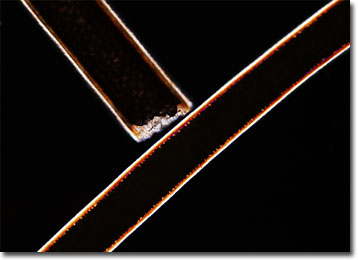Polarized Light Microscopy Digital Image Gallery
Elk Hair
The word elk is a nonscientific term used to refer to several different animals. In Europe, for instance, members of the species Alces alces are commonly called elks, but in North America the moniker is more often applied to a related animal called the wapiti.

The short-necked, long-legged mammals called elks in Europe are better known as moose in the United States and Canada. Weighing in at about 1,800 pounds and growing to shoulder heights more than six feet high, these inhabitants of northern regions are the largest affiliates of the deer family, Cervidae. A fleshy protrusion called a dewlap or bell hangs from the throat of the animals, which usually exhibit shaggy brown fur that does not spin well, but is sometimes utilized by fisherman for fly tying. The most notable physical attribute of the European elk is, however, the huge pair of antlers that are displayed by the male. Desire to gain these sizable, bony protuberances as a trophy has inspired many hunters to actively pursue elks, a fact that has decreased their numbers significantly in some parts of their range.
Europeans that first came to settle the continent of North America mistakenly called the wapiti, which is the second most sizable member of the deer family, an elk, and the name has endured in the region. The animal’s original moniker, however, stemmed from a Shawnee Indian word for “white,” a reference to its lightly colored rump, which stands in stark contrast to the reddish- or grayish-brown hues that are featured on the rest of the body. Similar to the European elk, wapiti bulls often feature large, branching antlers, which are sometimes used as weapons, especially during breeding season. Male wapitis also produce loud, bugling calls during this time of year in order to intimidate and deter competitors.
